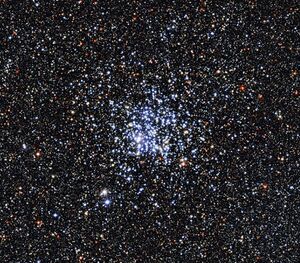Astronomy:Wild Duck Cluster
| Wild Duck Cluster | |
|---|---|
 Open cluster Messier 11 in Scutum | |
| Observation data (J2000.0 epoch) | |
| Constellation | Scutum |
| Right ascension | 18h 51m 05.0s[1] |
| Declination | −06° 16′ 12″[1] |
| Distance | 6,120 light-years (1,877 pc)[2] |
| Apparent magnitude (V) | 5.8[3] |
| Apparent dimensions (V) | 22.8′[2] |
| Physical characteristics | |
| Mass | 11,000[4] M☉ |
| Radius | 95 ly[4] |
| Estimated age | 316±50 million yrs[5] |
| Other designations | Messier 11, NGC 6705, Cr 391, Mel 213, OCl 76.0[6] |
The Wild Duck Cluster (also known as Messier 11, or NGC 6705) is an open cluster of stars in the constellation Scutum (the Shield). It was discovered by Gottfried Kirch in 1681.[3] Charles Messier included it in his catalogue of diffuse objects in 1764. Its popular name derives from the brighter stars forming a triangle which could resemble a flying flock of ducks[3] (or, from other angles, one swimming duck). The cluster is located just to the east of the Scutum Star Cloud midpoint.[7]
The Wild Duck Cluster is one of the richest and most compact of the known open clusters. It is one of the most massive open clusters known, and it has been extensively studied. Its age has been estimated to about 316 million years.[5] The core radius is 1.23 pc (4.0 ly) while the tidal radius is 29 pc (95 ly). Estimates for the cluster's mass range from 3,700 M☉[8] to 11,000 M☉,[4] depending on the method chosen. The brightest cluster member is visual magnitude 8, and it has 870 members of at least magnitude 16.5. It has an integrated absolute magnitude of –6.5, and a visual extinction of 1.3.[7]
The cluster is metal-rich with an iron abundance of [Fe/H] = 0.17±0.04. Despite its youth, it shows an enhancement of Alpha process elements. Possibly this is due to an enhancement of its birth molecular cloud by a nearby Type II supernova explosion.[5] At least nine variable star members have been identified with high probability, plus 29 lower probability members. The former include two eclipsing binary star systems.[9] The cluster is located 6.8 kpc (22,000 ly) from the Galactic Center, close to the galactic plane, and is not far from its birthplace.[5]
Gallery
-
A portion of M11, imaged by the Hubble Space Telescope.[10]
-
The blue stars in the centre of the image are the young, hot stars of the cluster.[11]
-
M11 is visible with binoculars in the constellation of Scutum.
See also
References
- ↑ 1.0 1.1 Wu, Zhen-Yu et al. (November 2009), "The orbits of open clusters in the Galaxy", Monthly Notices of the Royal Astronomical Society 399 (4): 2146–2164, doi:10.1111/j.1365-2966.2009.15416.x, Bibcode: 2009MNRAS.399.2146W.
- ↑ 2.0 2.1 Kharchenko, N. V. et al. (2005), "Astrophysical parameters of Galactic open clusters", Astronomy and Astrophysics 438 (3): 1163–1173, doi:10.1051/0004-6361:20042523, Bibcode: 2005A&A...438.1163K.
- ↑ 3.0 3.1 3.2 O'Meara, Stephen James; Levy, David H. (1998), Deep-Sky Companions: The Messier Objects, Cambridge University Press, p. 65, ISBN 978-0521553322, https://books.google.com/books?id=jis4evHuuzUC&pg=PA65.
- ↑ 4.0 4.1 4.2 Santos, J. F. C. Jr. et al. (October 2005), "Structure and stellar content analysis of the open cluster M 11 with 2MASS photometry", Astronomy and Astrophysics 442 (1): 201–209, doi:10.1051/0004-6361:20053378, Bibcode: 2005A&A...442..201S.
- ↑ 5.0 5.1 5.2 5.3 Casamiquela, L. et al. (March 2018), "NGC 6705 a young α-enhanced open cluster from OCCASO data", Astronomy & Astrophysics 610: 10, doi:10.1051/0004-6361/201732024, A66, Bibcode: 2018A&A...610A..66C.
- ↑ "M 11". SIMBAD. Centre de données astronomiques de Strasbourg. http://simbad.u-strasbg.fr/simbad/sim-basic?Ident=M+11.
- ↑ 7.0 7.1 Crossen, Craig; Rhemann, Gerald (2012), Sky Vistas: Astronomy for Binoculars and Richest-Field Telescopes, Springer Science & Business Media, p. 56, ISBN 978-3709106266, https://books.google.com/books?id=3vELBwAAQBAJ&pg=PA56.
- ↑ Cantat-Gaudin, T. et al. (September 2014), "The Gaia-ESO Survey: Stellar content and elemental abundances in the massive cluster NGC 6705", Astronomy & Astrophysics 569: 18, doi:10.1051/0004-6361/201423851, A17, Bibcode: 2014A&A...569A..17C.
- ↑ Messina, S. et al. (April 2010), "ACE-OC project: rotation and variability in the open cluster M 11 (NGC 6705)", Astronomy and Astrophysics 513: 26, doi:10.1051/0004-6361/200912373, A29, Bibcode: 2010A&A...513A..29M.
- ↑ "Wild cosmic ducks" (in en). https://www.spacetelescope.org/images/potw1912a/.
- ↑ "Wild Ducks Take Flight in Open Cluster". European Southern Observatory. http://www.eso.org/public/news/eso1430/.
External links
| Wikimedia Commons has media related to Wild Duck Cluster. |
- Messier 11, SEDS Messier pages
- Messier 11, Wild Duck Cluster
- Messier 11 - LRGB result based on 2 hrs total data
- The Wild Duck Cluster on WikiSky: DSS2, SDSS, GALEX, IRAS, Hydrogen α, X-Ray, Astrophoto, Sky Map, Articles and images
Coordinates: ![]() 18h 51.1m 00s, −06° 16′ 00″
18h 51.1m 00s, −06° 16′ 00″
 |
![A portion of M11, imaged by the Hubble Space Telescope.[10]](/wiki/images/thumb/d/dc/Wild_cosmic_ducks_Messier_11.jpg/120px-Wild_cosmic_ducks_Messier_11.jpg)
![The blue stars in the centre of the image are the young, hot stars of the cluster.[11]](/wiki/images/thumb/4/4a/Eso1430a.jpg/120px-Eso1430a.jpg)



